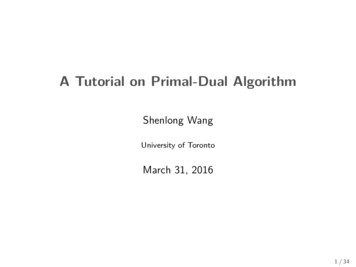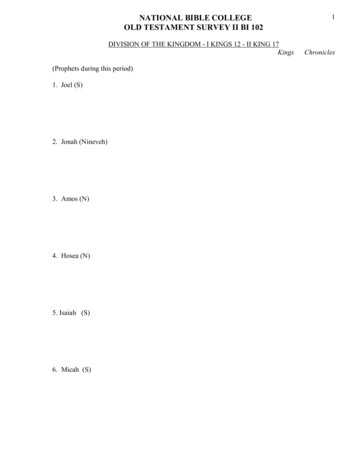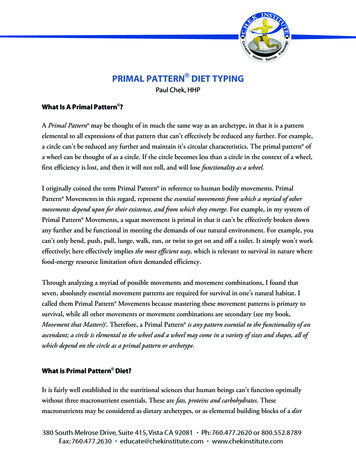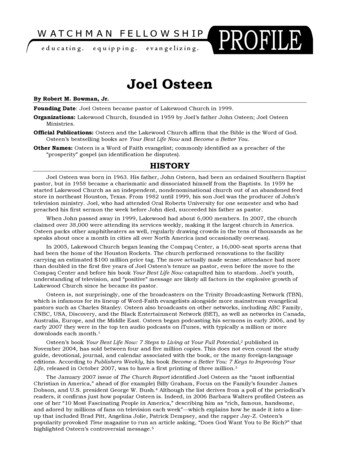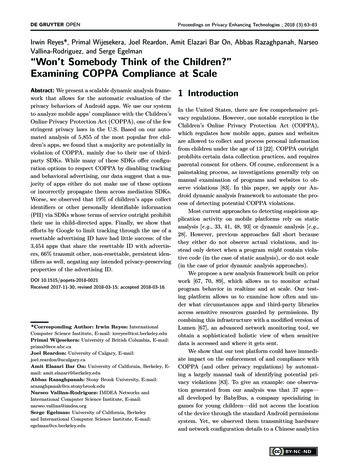
Transcription
Proceedings on Privacy Enhancing Technologies ; 2018 (3):63–83Irwin Reyes*, Primal Wijesekera, Joel Reardon, Amit Elazari Bar On, Abbas Razaghpanah, NarseoVallina-Rodriguez, and Serge Egelman“Won’t Somebody Think of the Children?”Examining COPPA Compliance at ScaleAbstract: We present a scalable dynamic analysis framework that allows for the automatic evaluation of theprivacy behaviors of Android apps. We use our systemto analyze mobile apps’ compliance with the Children’sOnline Privacy Protection Act (COPPA), one of the fewstringent privacy laws in the U.S. Based on our automated analysis of 5,855 of the most popular free children’s apps, we found that a majority are potentially inviolation of COPPA, mainly due to their use of thirdparty SDKs. While many of these SDKs offer configuration options to respect COPPA by disabling trackingand behavioral advertising, our data suggest that a majority of apps either do not make use of these optionsor incorrectly propagate them across mediation SDKs.Worse, we observed that 19% of children’s apps collectidentifiers or other personally identifiable information(PII) via SDKs whose terms of service outright prohibittheir use in child-directed apps. Finally, we show thatefforts by Google to limit tracking through the use of aresettable advertising ID have had little success: of the3,454 apps that share the resettable ID with advertisers, 66% transmit other, non-resettable, persistent identifiers as well, negating any intended privacy-preservingproperties of the advertising ID.DOI 10.1515/popets-2018-0021Received 2017-11-30; revised 2018-03-15; accepted 2018-03-16.*Corresponding Author: Irwin Reyes: InternationalComputer Science Institute, E-mail: ioreyes@icsi.berkeley.eduPrimal Wijesekera: University of British Columbia, E-mail:primal@ece.ubc.caJoel Reardon: University of Calgary, E-mail:joel.reardon@ucalgary.caAmit Elazari Bar On: University of California, Berkeley, Email: amit.elazari@berkeley.eduAbbas Razaghpanah: Stony Brook University, E-mail:arazaghpanah@cs.stonybrook.eduNarseo Vallina-Rodriguez: IMDEA Networks andInternational Computer Science Institute, E-mail:narseo.vallina@imdea.orgSerge Egelman: University of California, Berkeleyand International Computer Science Institute, E-mail:egelman@cs.berkeley.edu1 IntroductionIn the United States, there are few comprehensive privacy regulations. However, one notable exception is theChildren’s Online Privacy Protection Act (COPPA),which regulates how mobile apps, games and websitesare allowed to collect and process personal informationfrom children under the age of 13 [22]. COPPA outrightprohibits certain data collection practices, and requiresparental consent for others. Of course, enforcement is apainstaking process, as investigations generally rely onmanual examination of programs and websites to observe violations [83]. In this paper, we apply our Android dynamic analysis framework to automate the process of detecting potential COPPA violations.Most current approaches to detecting suspicious application activity on mobile platforms rely on staticanalysis [e.g., 33, 41, 48, 93] or dynamic analysis [e.g.,28]. However, previous approaches fall short becausethey either do not observe actual violations, and instead only detect when a program might contain violative code (in the case of static analysis), or do not scale(in the case of prior dynamic analysis approaches).We propose a new analysis framework built on priorwork [67, 70, 89], which allows us to monitor actualprogram behavior in realtime and at scale. Our testing platform allows us to examine how often and under what circumstances apps and third-party librariesaccess sensitive resources guarded by permissions. Bycombining this infrastructure with a modified version ofLumen [67], an advanced network monitoring tool, weobtain a sophisticated holistic view of when sensitivedata is accessed and where it gets sent.We show that our test platform could have immediate impact on the enforcement of and compliance withCOPPA (and other privacy regulations) by automating a largely manual task of identifying potential privacy violations [83]. To give an example: one observation generated from our analysis was that 37 apps—all developed by BabyBus, a company specializing ingames for young children—did not access the locationof the device through the standard Android permissionssystem. Yet, we observed them transmitting hardwareand network configuration details to a Chinese analytics
“Won’t Somebody Think of the Children?”what data do they access and with whom do they shareit) and (ii) direct notice and ask for verifiable parentalconsent prior to collection, usage, or disclosure of anyPII, and ensure that the consenting party is in fact a legal parent or guardian. While the COPPA rule does notrequire one specific method to obtain consent, it doesrequire the method be “reasonably designed in light ofavailable technology.” Disclosing personal information tothird parties, such as advertising agencies, requires reliable methods of verification of parental consent, suchas payment systems, signed forms, or phone calls [84].COPPA’s definition of PII is relatively broad, covering such items as contact information (e.g., email addresses and phone numbers), audio or visual recordings,and precise geolocation data (i.e., at the granularityof street name and city/town). Additionally, under the2013 amendments to the COPPA rule, persistent identifiers (e.g., IMEI and MAC addresses) are consideredPII if they “can be used to recognize a user over timeand across different websites or online services.”3There are certain rules that developers and thirdparty services must follow when using legitimately collected PII. Any PII collected from children cannot beused for profiling (e.g., behavioral advertising) or crossdevice tracking. However, certain limited pieces of PIImay be collected without parental consent if the datais used in “support for the internal operations” of theservice. The regulation defines supporting internal operations as “those activities necessary to:”4Examining COPPA Compliance at Scale652.1 Enforcement ActionsThe FTC has moved against a number of app developersand third-party service providers for gathering PII fromchildren: in 2014, children’s app developer BabyBus received a warning about its potential collection of geolocation data [21]; in 2015, the FTC collected a 360K settlement from app studios LAI Systems, LLC and RetroDream for allowing integrated third-party services to access and collect persistent identifiers [24]; and in 2016,the ad network InMobi was fined 1 million for gathering the locations of users—including children—withoutproper consent [23]. While these actions might push developers and third-party providers to be more vigilant,these are isolated incidents. Our work offers a systematic analysis of app behaviors that can help to uncoverwidespread misbehavior amongst apps, so that regulators and policymakers can improve accountability.2.2 Industry ResponseThis exemption allows, for instance, third-party analytics services to gather persistent identifiers, providedthat no other personal information is associated withit, that any identifiers collected are not used to contactor build profiles of specific users (i.e., for behavioral advertising), and that this data collection is necessary.While COPPA places liability on operators of childdirected services, the law exempts platforms, hostingservices, and distribution channels that “merely offerthe public access to someone else’s child-directed content.”5 Still, while the two largest app distribution platforms are therefore exempt, both the Google Play Storeand the Apple App Store have implemented measuresto help developers to comply with the law. Namely, developers can list their child-directed products in specialchild-targeted categories, provided that they observe requirements set by privacy laws and the distribution platform’s terms of service. The FTC further clarifies thatdistribution platforms be mindful of Section 5 of theFederal Trade Commission Act, which prohibits deceptive practices, and to not “misrepresent the level of oversight they provide for a child-directed app” [22].6The Google Play Store’s Designed for Families program (DFF) is an optional review process that entitles developers to list compliant apps under those special family-friendly categories and sections specificallyrelevant to children under 13. Developers participating in DFF agree that “apps submitted to Designedfor Families are compliant with COPPA and other relevant statutes, including any APIs that your app usesto provide the service” [34, 36]. DFF also sets restric-3 16 C.F.R. §312.2.4 Ibid.5 78 Fed. Reg. 3977.6 78 Fed. Reg. 3978.(i) Maintain or analyze the functioning of the Web site oronline service;(ii) Perform network communications;(iii) Authenticate users of, or personalize the content on,the Web site or online service;(iv) Serve contextual advertising on the Web site or onlineservice or cap the frequency of advertising;(v) Protect the security or integrity of the user, Web site,or online service;(vi) Ensure legal or regulatory compliance; or(vii) Fulfill a request of a child as permitted by §312.5(c)(3)and (4).
“Won’t Somebody Think of the Children?”3.2 Analysis EnvironmentOur dynamic analysis focuses on two aspects: how appsaccess sensitive data and with whom they share it. Theformer is achieved through a custom version of Android,while the latter is achieved through a custom VPN service, which acts as a localhost man-in-the-middle proxy.In our custom Android platform (based on v6.0.1),we modified Android’s permission system to enable thereal-time monitoring of apps’ access to protected resources (e.g., location data, address book contacts, etc.).We instrumented all the functions in the Android platform that access these sensitive resources (i.e., wheneveran app accesses a permission-protected resource, the instrumentation logs the access request). By building thiscapability into the Android platform, we can observeany Android app without modifying the app itself.Our framework also includes a modified version ofLumen [67], a network monitoring tool that capturesall network traffic generated by the app being tested.Lumen leverages Android’s VPN API to redirect all thedevice’s network traffic through a localhost service thatinspects all network traffic, regardless of the protocolused, through deep-packet inspection. Lumen installs aroot certificate in Android’s trusted store so it can alsoanalyze communications protected by TLS (certificatepinning notwithstanding) [65].While there have been some previous attempts atmonitoring resource usage and data sharing in thewild [1, 67, 69, 77, 88, 92], we believe that ours is thefirst end-to-end analysis platform that can automatically monitor when data is first accessed and where itis ultimately sent.3.3 Automated App ExplorationSince our analysis framework is based on dynamic analysis, apps must be executed so that our instrumentationcan monitor their behaviors. Ideally, our testbed wouldexplore the same code paths that would be triggeredwhen apps are used normally.We use Android’s UI/Application Exerciser Monkey (the “Monkey”) [38]—a tool provided by Android’sdevelopment SDK—to automate and parallelize the execution of apps by simulating user inputs. The Monkeyinjects a pseudorandom stream of simulated user inputevents into the app, thereby simulating random UI interactions; it essentially “fuzzes” an app’s UI. Becausethis pseudorandom input is generated from a randomseed, it is also reproducible.Examining COPPA Compliance at Scale67Our testing pipeline schedules each app to run for10 minutes on a Nexus 5X, with the Monkey generating input events during this time period. After each10 minute execution slot, logs are generated based onthe observed behaviors. After each execution, the devicegoes through a cleaning phase to isolate each test runfrom one another. In the current setup, we can analyzeapproximately 1,000 apps/day on 8 phones.One obvious question regarding the Monkey is howwell it is able to uncover the same app functionality thata real user might encounter [2]. Unlike real users, a pseudorandom input generator does not process app visualcues. For example, it does not immediately know that itneeds to click a button to dismiss a dialog. This mightresult in sub-optimal execution path coverage. Therefore, the evaluation presented in this paper is a lowerbound of what an app can do while interacting with ahuman user: more potential violations are possible dueto the execution paths unexplored by the Monkey.To better understand the effectiveness of the Monkey, we compared its performance to that of a humanuser. We evaluated it both in terms of the number ofAndroid “Activities” uncovered—unique screens withinan app—as well as the number of data flows recorded.We instructed our human tester to explore each app for10 minutes and to manipulate all interactive elements.Similarly, we configured the Monkey to test each appfor 10 minutes, producing a random input every second.We used the Monkey’s built-in options to constrain itsexploration to the app being tested.We performed this parallel testing on an initial corpus of 401 apps in December 2016. When comparing thecoverage of each method, the human tester missed 9% ofthe Activities that the Monkey uncovered, whereas theMonkey missed 39% of the Activities that the humanuncovered. That is, the Monkey matched or exceededthe human’s app screen coverage 61% of the time. Interms of network flows, the human and Monkey testersmissed 20% and 34%, respectively. Based on this analysis, we concluded that the Monkey may incur false negatives (i.e., not detecting potential privacy violations),but any potential privacy violations uncovered in ourtesting environment are observations of actual app behaviors, so it does not generate false positives. Therefore, the results produced by our method represent alower bound of potential COPPA violations.
“Won’t Somebody Think of the Children?”3.4 Post ProcessingThe final stage of the pipeline is to analyze the log filesgenerated by our framework. These logs contain bothobserved permission requests and network flows. Weparse these logs by searching them for custom stringqueries depending on the type of data.For permission requests, we search the permissionlog for output from our instrumentation, which recordsthe type and context under which guarded resources areaccessed. For network flows, we search for identifiers asstring values associated to the particular testing device,such as the phone number, IMEI, MAC address, location, etc., which are listed explicitly alongside each logfile at the time we perform our experiment. We only report leaks of these identifiers if we find any of them inan outgoing flow emitted by the tested app.Because we wrote the instrumentation that monitors guarded resource accesses, detecting these accessesis straightforward. Finding PII inside network transmissions, however, is a greater challenge because differentapps and SDKs use different encodings to transmit PII.Our approach to decoding obfuscated network flowsis to find packets that appear to be sending some meaningful data, but for which we were not identifying anyPII. We manually inspect and decode this traffic, andthen create regular expressions to automatically decodeall similarly encoded traffic in the future. Aside fromstandard encodings, such as base64, URL encoding, andHTML character encoding, we also search for permutations of identifiers: upper and lower cases, strings andbinary representations, as well as the values resultingfrom the MD5, SHA1, and SHA256 hashing algorithms.We observe that these hash functions are intendedto be non-reversible, but the resulting value remains aunique identifier with the same persistent properties asthe original, meaning that its suitability for tracking remains the same. Moreover, a brute-force search to reverse a hash value is easily feasible for many identifierssimply because their domain is insufficiently large. Examples of identifiers with a small domain include serialnumbers, IMEIs, and phone numbers.Additionally, for a handful of advertising and analytics SDKs, we also reversed their use of bespoke encodings to transmit PII. For example, ironSource usesAES/CBC with a fixed encryption key (embedded inthe SDK) to transmit an initial request for configuration options that includes the advertising ID and sometimes other identifiers, including the e-mail address andIMEI. They use this mechanism despite the use of TLS.StartApp sends location data (when available to theExamining COPPA Compliance at ScalePIIDescriptionAAIDAndroid IDGSF IDHW IDIMEISIM IDMAC AddressAndroid Advertising IDUnique ID created at Android setupGoogle Services Framework IDPhone hardware ID (serial number)Mobile phone equipment IDSIM card IDMAC address of WiFi interfaceEmailPhone #Latitude, LongitudeRouter MAC AddressRouter SSIDEmail address of phone ownerMobile phone’s numberUser locationMAC addresses of nearby hotspotsSSIDs of nearby hotspots68Table 1. The types of personal information that are detected inour analysis logs. The top half of the table lists persistent IDs.app), as well as MAC addresses and other PII usinga Vigenère-style XOR-based encoding using the mask“encryptionkey” and a leetspeak mutation of theircompany name. Flurry rounds the location coordinatesto three decimals and then sends the binary encodingof the resulting floating-point number. ComScore sendsthe MD5 hash of the hardware serial number by firstprefixing it with a per-developer secret ID. Two developers, Disney and Turner, comprise the majority of appsusing comScore in our dataset, and so we reversed thesecret ID for both developers, compute the resultinghashed serial number, and categorize any transmissionsof it as a transmission of the serial number.Table 1 lists the types of information that we searchfor in our log files. The top half of the table lists specific identifiers. The Android Advertising ID (AAID)was created by Google as a compromise between allowing user tracking (e.g., for behavioral advertising andprofiling) and giving users more control over their privacy: users can reset this identifier or check a box toprevent long-term tracking (the latter option causes a“do not track” flag to be transmitted). Of course, if thisidentifier is collected alongside other persistent identifiers, this would undermine the intended privacy protections. To prevent this, Google’s terms of use indicatethat “the advertising identifier must not be connectedto personally-identifiable information or associated withany persistent device identifier (for example: SSAID,MAC address, IMEI, etc.) without explicit consent ofthe user” [40]. The other identifiers we examine are either hardware-based and cannot be reset (e.g.,, IMEI,MAC address) or cannot be reset easily: the AndroidID can only be changed via a factory reset, the GSF IDcan be reset by creating a new Google account, and theSIM ID can be reset by replacing the SIM card.
“Won’t Somebody Think of the Children?”As geolocation coordinates are numerical values, wedetect the presence of geolocation data in network flowsby identifying the latitude and longitude as numberswritten out as a string in decimal that matches the integer component and at least the first three decimal values. We also search for the precise latitude and longitudewritten as a floating-point number and in binary, as wellas those values rounded to 3, 4, and 5 decimal places.We require that both the latitude and the longitude appear in the same packet for our instrumentation to consider it a transmission of location. This degree of precision means that our location information was sent with100 meters of accuracy—well within COPPA’s standardof street-level accuracy [22].4 AnalysisWe performed automated analysis on 5,855 Androidapps that agree to abide by COPPA as part of their inclusion in the Play Store’s Designed for Families (DFF)program. Of these 5,855 apps, 28% accessed sensitivedata protected by Android permissions. We also observed that 73% of the tested applications transmittedsensitive data over the Internet.7 While accessing a sensitive resource or sharing it over the Internet does notnecessarily mean that an app is in violation of COPPA,none of these apps attained verifiable parental consent:if the Monkey was able to trigger the functionality, thena child would as well. This suggests that many potential violations are likely occurring, which we discussin the remainder of this paper: we examine access topersonally-identifiable information, sharing of persistentidentifiers, the timing of when data is transmitted, andthe effectiveness of the Safe Harbor programs.4.1 Personal InformationIn this section, we present our results regarding apps’use of geolocation and contact information. From the5,855 applications tested, we found: 256 apps (4.4% of5,855) collecting geolocation data or data sufficient toinfer it; 107 sharing the device owner’s email address;and 10 sharing the phone number.7 Some of the COPPA-governed resources are not controlledby Android permissions (e.g., access to many of the persistentidentifiers), which is why we observed many more examples ofdata exfiltration than access to permission-protected resources.Examining COPPA Compliance at Scale694.1.1 Geolocation via Location APIsGeolocation data not only reveals where individuals live,but could also enable inferences about their socioeconomic classes, everyday habits, and health conditions,among others [20]. Such inferences could carry life-longimplications for children. The 2013 revision to COPPAwas in part motivated by the widespread availabilityof geolocation-enabled mobile apps for children. Unlike other types of identifiers that have exemptions toCOPPA’s consent requirements for performing activities like “contextual advertising” or “giving notice” [84],any access to geolocation information requires verifiableparental consent. That the Monkey was able to triggerthis functionality with random taps and swipes impliesthat verifiable parental consent is not being obtained.Of the 5,855 apps analyzed during the study period,706 declared either the access fine location or access coarse location permissions in their manifests, which means that they—and their bundled thirdparty libraries—could potentially access location data.Our instrumentation observed 235 apps (4.0% of 5,855)actually accessing this data by calling Android locationAPIs that reveal GPS coordinates. These apps had acumulative install count of 172M (an average of 734K).Given the lack of verifiable parental consent, justaccessing this data appears to be a potential violation,based on the FTC’s guidance [84]. Furthermore, 184of these apps also transmitted the location data, sharing it with a median of 3 unique domains. A total of107 unique domains received location data from theseapps. The most popular destinations were: mopub.com(85 apps), aerserv.com (84 apps), skydeo.com (80 apps),youapp.com (80 apps), and inner-active.mobi (76 apps).One particularly egregious example is app developerTinyLab. We observed that 81 of their 82 apps that wetested shared GPS coordinates with advertisers. Especially popular apps included:– Fun Kid Racing (v3.12, 10-50M installs): GPSdata shared with ads.aerserv.com (non-TLS),location-api.skydeo.com, and sdk.youappi.com– Fun Kid Racing–Motocross (v3.12, 10-50M installs): GPS data shared with dk.youappi.com, and sdkng.youappi.com– MotocrossKids–WinterSports (v3.15,5-10M installs): GPS data shared withwv.inner-active.mobi (non-TLS),c.adsymptotic.com (non-TLS), sdk.youappi.com,and location-api.skydeo.com
“Won’t Somebody Think of the Children?”Many of the companies receiving location data areadvertising firms whose business models rely on userprofiling to perform behavioral advertising, which is explicitly prohibited by COPPA. It is particularly important to note that MoPub, the most popular destinationfor location data among children’s apps, clearly statesin their terms of service that their service should notbe used by any app that collects data from anyone under 13 [61], likely because their privacy policy explicitlystates that collected data may be used for behavioraladvertising. We discuss the use of prohibited librariesin more detail in Section 4.3.1.Examining COPPA Compliance at Scale70cially when collected over time and across locations. Retrieving the names of saved networks does not requirean app to hold location privileges either. Because stringsearching for SSID names is prone to false positives, wemanually verified that the SSID values we discoveredwere indeed valid transmissions. We found 148 apps engaging in this behavior, including:– Disney’s “Where’s My Water? Free” (v1.10.0,100–500M installs): Wi-FI router name transmittedto control.kochava.com– Tiny Lab’s “Motocross Kids–Winter Sports”(v2.4.2, 10–50M installs): Wi-FI router name transmitted to api.greedygame.com4.1.2 Wi-Fi Router GeolocationAs an alternative to querying a phone’s GPS hardware,apps can retrieve the MAC address of the currentlyconnected Wi-Fi hotspot to infer a user’s location withstreet-level precision. This is because Wi-Fi hotspotstend to have fixed locations and MAC addresses thatuniquely identify them. Developers and tracking servicescan use Wi-Fi-based geocoding services, such as theGoogle Maps Geolocation API [37] or WiGLE.net [87],to map these MAC addresses to GPS coordinates.This technique allows app developers to determinethe user’s location without explicitly asking for the location permission or triggering the location notificationicon. The FTC has been pursuing companies engagingin this deceptive practice. For instance, in 2016, theyreached a 1M settlement with InMobi over this [23].To identify children’s apps that potentially engagein Wi-Fi geolocation, we searched network flows forMAC addresses and SSIDs of the currently-connectedWi-Fi router. We observed 101 children’s apps sharing Wi-Fi router MAC addresses with third parties.The most common recipients were: greedygame.com(61 apps), startappservice.com (60 apps), startappexchange.com (57 apps), kochava.com (30 apps), and appnxt.net (13 apps). Example apps include:– Yousician’s“GuitarTunerFree—GuitarTuna” (v4.3.6, 10–50M installs): Wi-Firouter MAC transmitted to control.kochava.com– TabTale’s “Pop Girls–High School Band”(v1.1.9, 1–5M installs): Wi-FI router MAC transmitted to init.startappservice.comAlthough not as distinct as Wi-Fi router MAC addresses, human-readable network names (SSIDs) canstill allow some inferences about users’ locations, espe-4.1.3 Contact InformationAndroid API access to contact information is protected by two different permissions: get accountscan identify email addresses and other accounts(e.g., Twitter username) accessed by the device, andread phone state can read the device’s phone number. Out of the 5,855 applications we tested, 775 declared the get accounts permission, which meansthat 13% could access contact information. Subsequently, we observed 254 apps (4.3%) actually accessingthis information during testing. Similarly, 1,780 applications declared the read phone state permission,and we observed 634 (10.8%) actually accessing information protected by this permission. The mere collection of this information may not be a violation of thelaw by itself, since there are several limited exemptionsfor collecting contact information without first attaining verifiable parental consent [84].However, the transmission of contact information,in particular to third parties, may be more indicative of a potential COPPA violation. Our testing found107 children’s apps that transmitted the device owner’semail address to remote servers. The five most commondestinations were: appspot.com (79 apps), tinylabproductions.com (19 apps), google.com (10 apps), skydeo.com (5 apps), and drgames.fr (3 apps). The transmission of phone numbers was less common: just 10 outof the 5,855 children’s apps shared this data with remoteservices. The following domains received phone numbers: drgames.fr (3 apps), cafe24.com (2 apps), oneaudience.com (2 apps), gameloft.com (1 apps), and mamabearapp.com (1 app).
“Won’t Somebody Think of the Children?”4.2 Insecure TransmissionsCOPPA requires that children’s apps “must establishand maintain reasonable procedures to protect the confidentiality, security, and integrity of personal information collected from children.”8 To examine apps’ compliance with this clause, we examined the usage of TLS,when transmitting any type of personal information (including persistent identifiers). Overall, we observed that2,344 DFF apps do not use TLS in at least one transmission containing identifiers or other sensitive information (40.0% of 5,855 apps analyzed). This number alsolikely represents an upper bound on usage of reasonableprocedures to transmit personal information, becausewe did not examine whether apps that do use TLS aredoing so correctly (e.g., proper validation) [65]. Giventhat TLS is the standard method for securely transmitting information, it could be argued that almost halfthe apps we examined are not taking “reasonable procedures to protect the confidentiality, security, and integrity of personal information collected from children.”4.3 Persistent IdentifiersPersistent identifiers in Android can be used to identifydevices and their users over time and across differentservices (Table 1). Using persistent identifiers withoutverifiable parental consent is allowed under COPPA, aslong as the identifiers are being used for “internal operations,” which the Rule has defined to include “serv[ing]contextual advertisements” [84]. Contextual advertisements refer to ads that are targeted only based on thetype of app or service being
Computer Science Institute, E-mail: ioreyes@icsi.berkeley.edu Primal Wijesekera: University of British Columbia, E-mail: primal@ece.ubc.ca Joel Reardon: University of Calgary, E-mail: joel.reardon@ucalgary.ca Amit Elazari Bar On: University of California, Berkeley, E-mail: amit.elazari@berkeley.edu Abbas Razaghpanah: Stony Brook University, E-mail:


